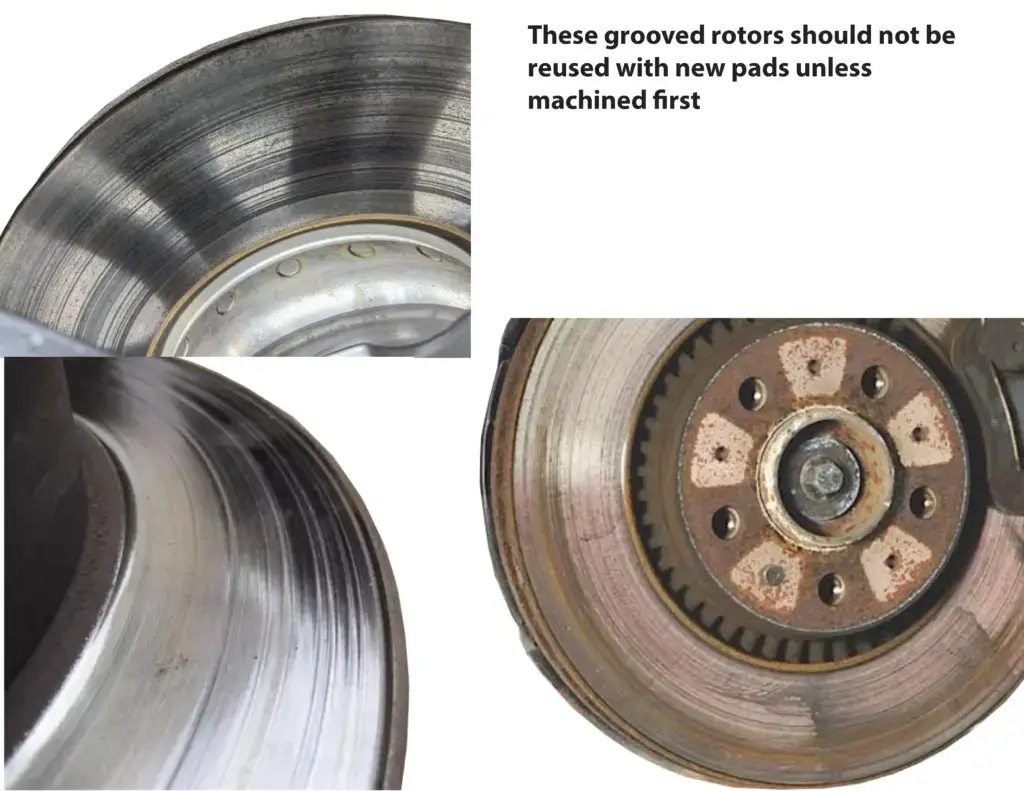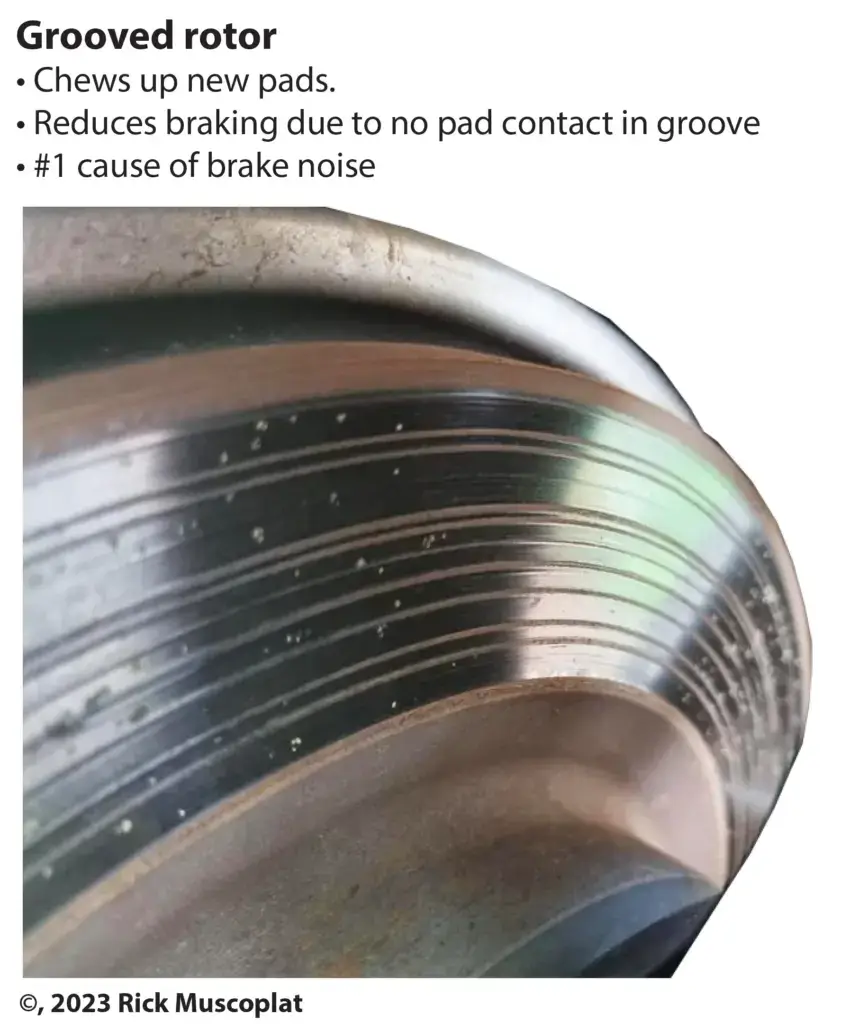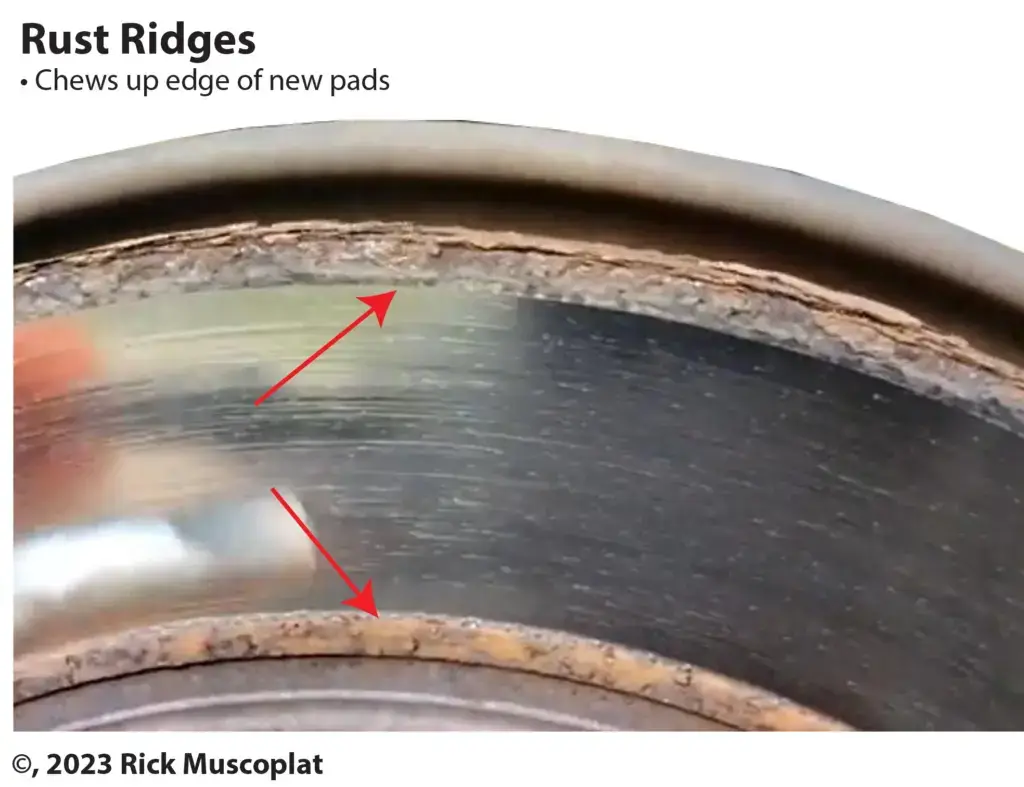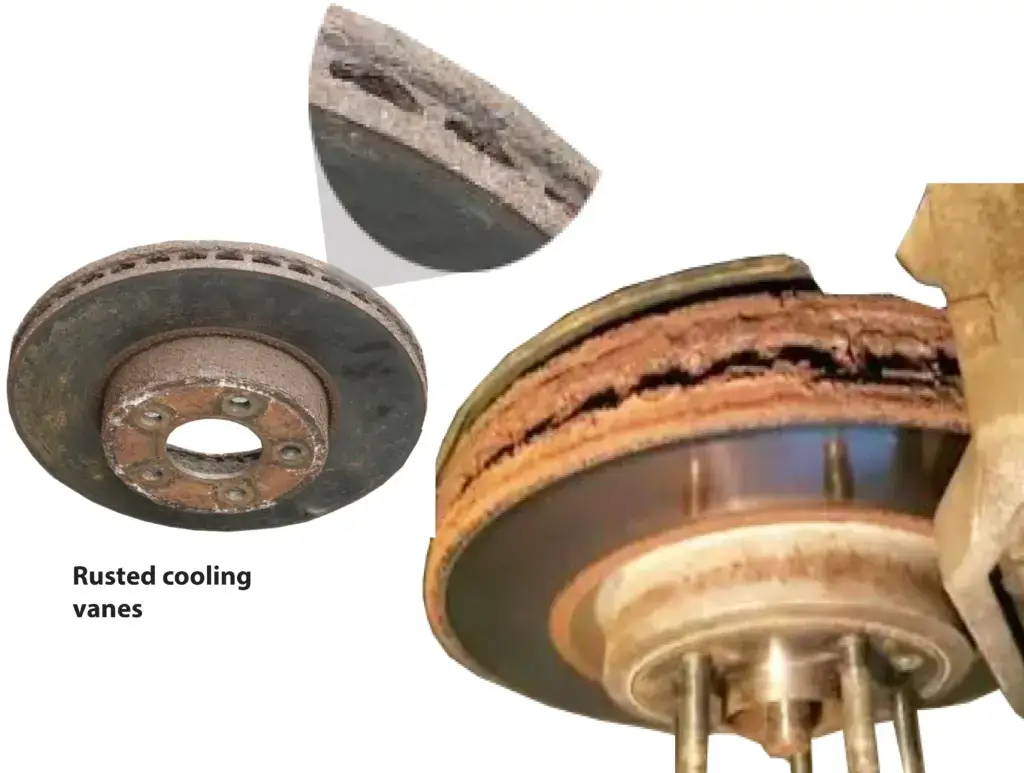Can you install new brake pads on old rotors?
You can install new brake pads on old rotors, but it’s not a good idea
Most old rotors have grooves in the rotor face and rust in the cooling vanes. Reusing old rotors without machining the rotor face or at least cleaning out the cooling vanes is just a bad idea.
Grooved rotors reduce braking power until the brake pads wears into the groove
The flat brake pad will only touch the top ridges of the grooves until it wears into the grooves. That can take up to 10,000 miles, during which you’ll have reduced braking power.
In addition to reduced braking, the grooves can actually chew up the pads near the edges of each groove, causing your new pads to wear out faster. Worse yet, the pad contact along the grooves creates additional vibration that translates into brake squeal and screech. Putting new pads on old rotors is the #1 cause of brake noise, which is why most shops won’t do it; they don’t want the noise complaints.
If the rotor has rust ridges, it should not be reused
Brake pads don’t contact entire the rotor face; there’s usually a small area on the outer circumference that isn’t touched by the pad as well as a small area near the rotor hat that isn’t touched by the brake pad.
The area of the rotor that’s in contact with the pad will wear, while the outer and inner areas will not; so those areas will be slightly thicker. In addition, those areas often rust, forming an inner and outer rust ridge.
If you install new brake pads on a rotor with rust ridges, the inner and outer rust areas will reduce brake pad contact with the center portion and wear down the outer and inner areas of the brake pad, causing brake noise.
Rusted cooling vanes drastically reduce rotor cooling
The vast majority of DIYers ignore the issue 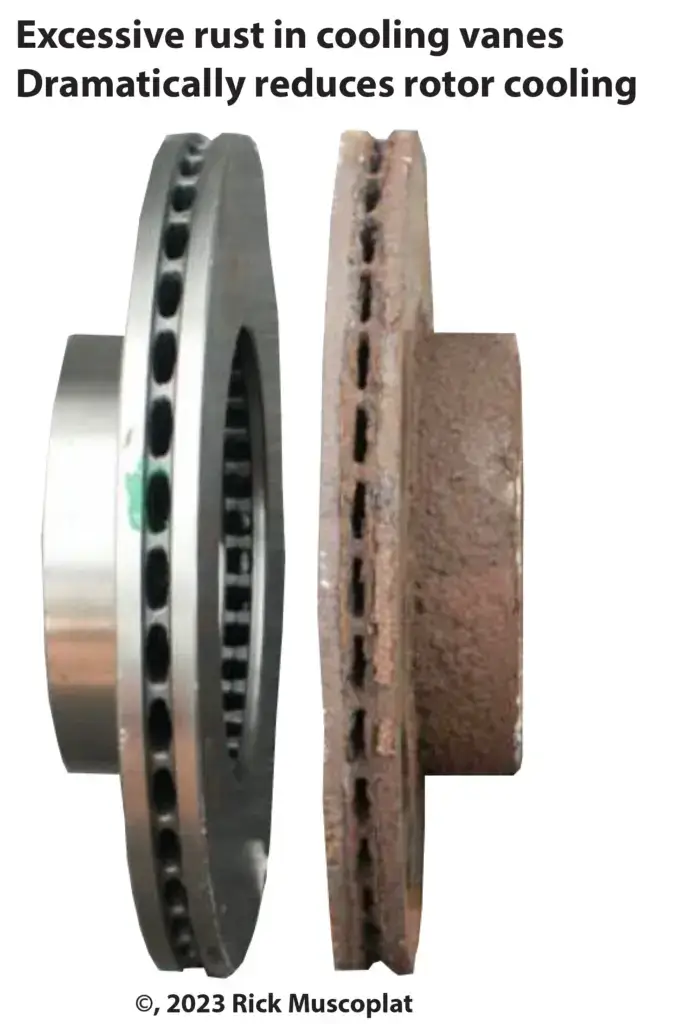 of rusted cooling vanes. Yet rotor cooling is the single most important issue in brake performance and brake life. It’s just a fact that cast iron rusts and when rust forms in the cooling vanes, the rust interrupts airflow and acts as an insulator preventing heat transfer to the air.
of rusted cooling vanes. Yet rotor cooling is the single most important issue in brake performance and brake life. It’s just a fact that cast iron rusts and when rust forms in the cooling vanes, the rust interrupts airflow and acts as an insulator preventing heat transfer to the air.
If your cooling vanes are rusted and you reuse those rotors, you’re reducing braking performance and decreasing the life of your brakes.
Look at the incredible difference in cooling vane sizes between a new rotor and a used rotor. How in the world do you think the old rusted rotor could possibly cool properly?
Worse yet, you’ll have a much harder time establishing a transfer layer (scroll down to read about the transfer layer).
If you install new brake pads on old rotors, you have brake noise
The rotor face on your old rotors may look perfectly flat, but it’s not. In addition, the rotor face has a thin film transfer layer of friction material from your old pads. If you install new brake pads on old rotors, the old transfer layer will contaminate your new pads, resulting in brake noise.
How to check your old brake rotors
• Are there any grooves on the old rotor deeper than 1/16″? If so, you can’t reuse that rotor.
• Does the rotor exceed the “Discard thickness” stamped into the rotor? If yes, it’s possible that it can be reused if it meets the other criteria.
• Is there flaking rust accumulation in the cooling vanes? If you can remove the majority of the rust, you can possibly re-use it if it meets the other criteria.
• Is you getting any brake pedal pulsation? If yes, you can’t reuse the old rotors.
• If the rotor face is shiny, you’ll have a much harder time bedding in the new brake pads and the new pads will most likely cause noise issues even after they’re “bedded.”
Rotor surface condition is important
There are two types of brake pad friction materials; abrasive and adherent. Semi-metallic pads are abrasive, while organic and ceramic are classified as adherent. Adherent friction material works by applying a transfer layer to the rotor, so braking is accomplished by rubbing friction material against friction material.
Abrasive braking is more like sandpaper against wood. In this case, the brake pad is the sandpaper and the wood is the rotor.
In both cases, the rotor face must have a smoothness.
How smooth is smooth when it comes to brake rotor surface conditions
Brake rotor surface “smoothness” is rated by its Roughness Average (RA). The proper RA is critical to achieving the proper transfer layer for adherent style brake organic and ceramic pads as well as abrasive semi-metallic brake pads.
If the surface is too smooth, it’s impossible to form a transfer layer onto the rotor face. If it’s too rough, the brakes will make noise, wear faster and even lose stopping power.
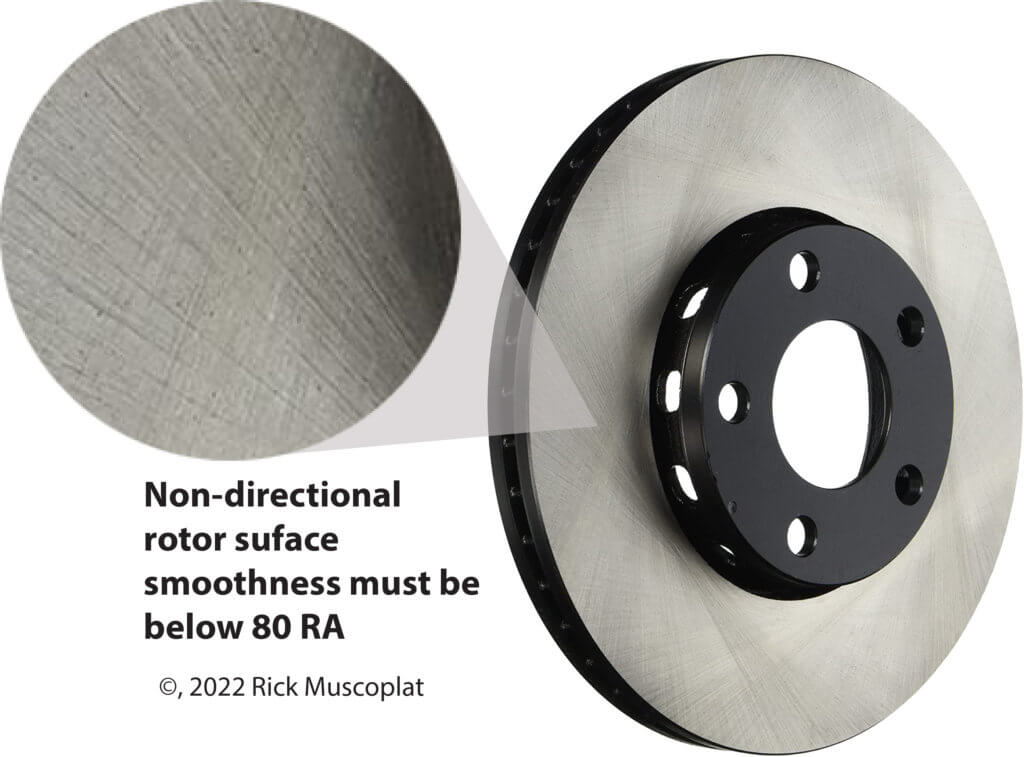
What happens when you install new pads on old rotors?
If the old rotors are shiny, you’re going to have a hard time establishing a new transfer layer. So using the proper bedding technique for the new pads is critical. You will most likely encounter noise and reduced braking until the rotors can re-establish the transfer layer.
In addition if the old rotors have grooves deeper than 1/16″, they can’t be reused. If the grooves are less than 1/16″, the new pads won’t provide full stopping power until the pads wear into the shape of the rotor. Since only a portion of the brake pad is touching the rotor, it will create noise.
©, 2021 Rick Muscoplat
Posted on by Rick Muscoplat

